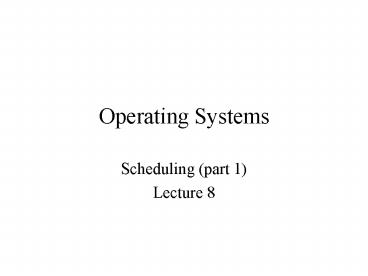Operating Systems PowerPoint PPT Presentation
Title: Operating Systems
1
Operating Systems
- Scheduling (part 1)
- Lecture 8
2
Why Multiprogramming
- OS is a process and must share the CPU with
application processes - Processes need to perform I/O
3
Scheduler Organization
- Scheduling policy -- when is it time to remove a
process from the CPU and which process should be
next allocated - Scheduling mechanism -- how the process manager
knows when to switch running processes and how to
allocate/deallocate a process from the CPU
4
Scheduling Mechanism
- Enqueuer
- Dispatcher
- Context Switcher
5
(No Transcript)
6
Scheduler Mechanism, cont.
- Saving Process Contexts
- Voluntary vs. involuntary sharing
- Performance issues
7
Scheduling Policy
- External Priorities
- Maximum equitability
- favor short/long running processes
- resource utilization
- maximized throughput
- average/maximum turnaround times
- maximized system availability
8
Scheduling Policy, cont.
- Deadlines
- Response time
- Fairness
- Optimal scheduling
9
Notation
- P Pi 0 lt i lt n -- processes
- t(Pi) -- how much time a process requires
- W(Pi) -- how long a process needs to spend before
its first transition to running - S(Pi) running, blocked, ready -- states
- Ttrnd(Pi) -- turnaround time. Time from when
process becomes ready until its done
10
Strategy background
- Throughput rate -- jobs/unit time
- Response time
- Batch systems vs. time sharing systems
- Resources -- involvement of I/O
- t(pi) t1 d1 t2 d2 tk dk tk1
11
Scheduling Strategies
- 2 types
- Non-preemptive -- once a process starts, it isnt
removed until it finishes or yields the processor - preemptive
- Analysing effectiveness through examining system
load - hypothetical load
- real load
12
System Load
- l - mean arrival rate of new processes to the
ready queue - 1/l - mean time between arrivals
- m - mean service rate
- 1/m - mean service time of a process
- Load (fraction of time the CPU is busy
- R l 1/m l/m
- If larger than 1, we have a problem
13
Non-preemptive strategies
- First Come First Served
- Shortest Job Next
- Priority Scheduling
PowerShow.com is a leading presentation sharing website. It has millions of presentations already uploaded and available with 1,000s more being uploaded by its users every day. Whatever your area of interest, here you’ll be able to find and view presentations you’ll love and possibly download. And, best of all, it is completely free and easy to use.
You might even have a presentation you’d like to share with others. If so, just upload it to PowerShow.com. We’ll convert it to an HTML5 slideshow that includes all the media types you’ve already added: audio, video, music, pictures, animations and transition effects. Then you can share it with your target audience as well as PowerShow.com’s millions of monthly visitors. And, again, it’s all free.
About the Developers
PowerShow.com is brought to you by CrystalGraphics, the award-winning developer and market-leading publisher of rich-media enhancement products for presentations. Our product offerings include millions of PowerPoint templates, diagrams, animated 3D characters and more.

